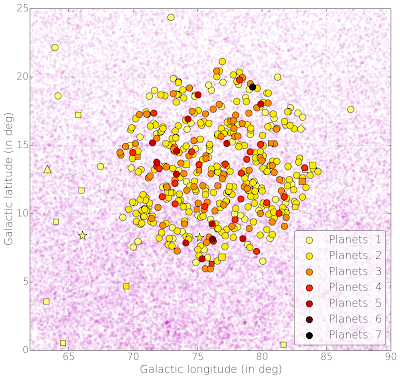There are many different surveys looking for new extra-solar planets. Right now the most successful technique is the transit method and there are many programs using this method. In this all sky map I was trying to show a few of these surveys which look at many stars, monitor their brightness, and try to find exoplanets in the stars' light curves.
Probably the most well-know survey is Kepler; it's the instrument that found the most planets until now. However, it looked at a very limited area of the sky. You can see it on the left side of the map where the large number of black dots are.
CoRoT was another space-based mission which was very successful; however, it did not nearly find as many exoplanets as Kepler. Its observing strategy was a bit different. CoRoT did not stare at one area in the sky all the time but switched its field of view every half year. One time it looked in the direction of the center of the Milky Way, which are the purple squares on the left side, and the next time it looked at an area in the opposite direction. These so-called 'anti-center' runs can be seen in the center of the map.
Also very successful is WASP. The nice thing about this survey is that (1) it observes from the ground and (2) it looks (almost) everywhere in the sky. The 104 planets I got from exoplanet.eu (including SuperWASP) are really quite a number.
There are lots of different missions listed in the legend of the map and I do not want to go into detail on everyone of them. It is not a complete list of programs but rather what I could made out of the information provided by exoplanet.eu. Unfortunately, it is kinda hard to find which planet was detected by which survey because this is not listed there. So the host stars (and planets) I plot here are named after the program they were found with - and this way I could plot them. However, this is not true for every planet found and also not true for every survey.
This is especially disappointing for the planets found with the RV method. I would have liked to plot all the RV planets coming from, e.g., HARPS, which is an amazingly successful instrument, but I could not easily collect the necessary information. The host stars usually keep their name because they are bright, well-known objects (with HD or HR numbers). So it's not possible for me to get the survey from the name alone.
After all, this map is supposed to give an impression of which transit surveys there are and how they observe. It's not meant to be complete. Furthermore, the detection method listed in the database is not always 'transit'. This is because some systems are re-observed in RV to get the mass of the planet. Others, e.g., OGLE are no transit survey, although they do observe light curves. It can by chance also find transits but OGLE is actually looking for the signatures of microlensing events.




